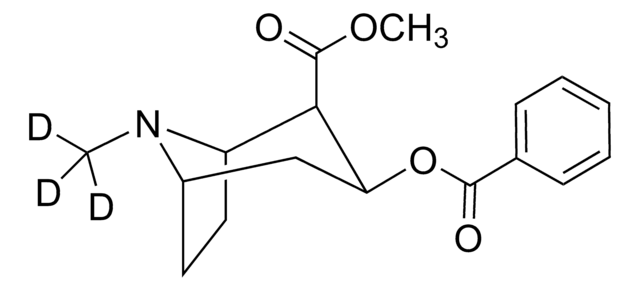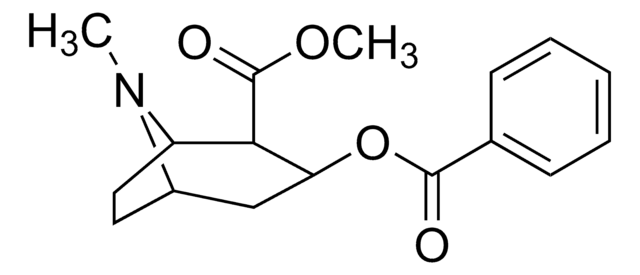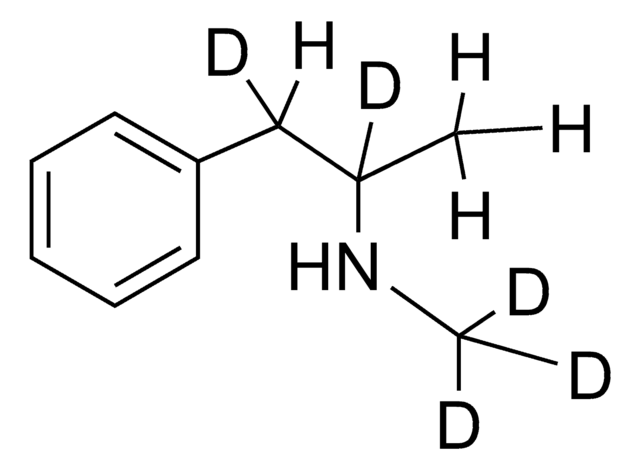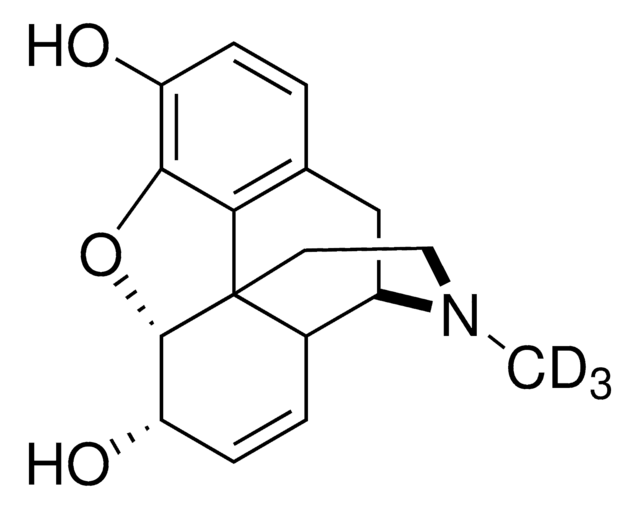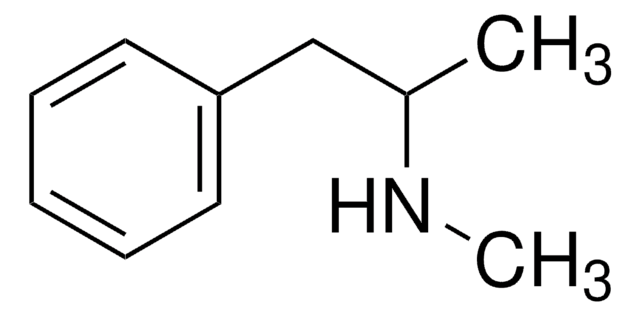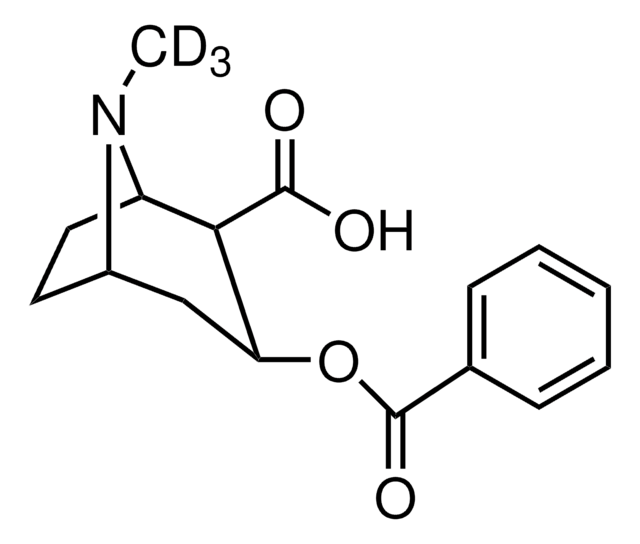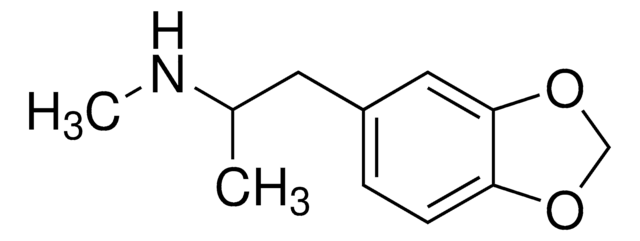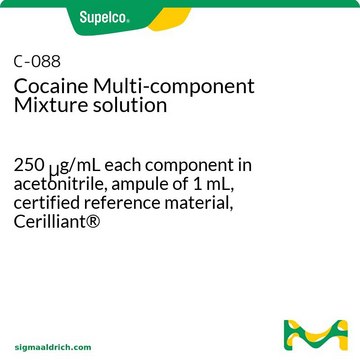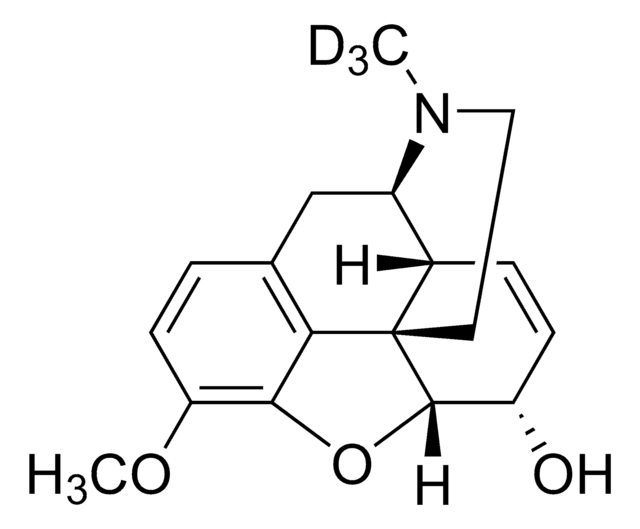Kluczowe dokumenty
B-001
Benzoylecgonine-d3 solution
100 μg/mL in methanol, ampule of 1 mL, certified reference material, Cerilliant®
Synonim(y):
Benzoylecgonine-N-methyl-d3 solution
About This Item
Polecane produkty
klasa czystości
certified reference material
Poziom jakości
Formularz
liquid
Właściwości
SNAP-N-SPIKE®, SNAP-N-SHOOT®
opakowanie
ampule of 1 mL
producent / nazwa handlowa
Cerilliant®
drug control
Narcotic Licence Schedule A (Switzerland); estupefaciente (Spain); Decreto Lei 15/93: Tabela IB (Portugal)
stężenie
100 μg/mL in methanol
metody
gas chromatography (GC): suitable
liquid chromatography (LC): suitable
Zastosowanie
forensics and toxicology
Format
single component solution
przesunięcie masy
M+3
Warunki transportu
wet ice
temp. przechowywania
−20°C
ciąg SMILES
[2H]C([2H])([2H])N1[C@H]2CC[C@@H]1[C@H]([C@H](C2)OC(=O)c3ccccc3)C(O)=O
InChI
1S/C16H19NO4/c1-17-11-7-8-12(17)14(15(18)19)13(9-11)21-16(20)10-5-3-2-4-6-10/h2-6,11-14H,7-9H2,1H3,(H,18,19)/t11-,12+,13-,14+/m0/s1/i1D3
Klucz InChI
GVGYEFKIHJTNQZ-GZBWLTEMSA-N
Szukasz podobnych produktów? Odwiedź Przewodnik dotyczący porównywania produktów
Opis ogólny
Zastosowanie
- Mass Spectrometry Internal Standard: Benzoylecgonine-d₃ is utilized as a robust internal standard in mass spectrometry to enhance the accuracy and precision of quantitative analysis of cocaine metabolites in clinical toxicology studies, providing crucial data for forensic and clinical applications (Handley et al., 2019).
- Forensic Toxicology Research: The application of Benzoylecgonine-d₃ in gas chromatography-mass spectrometry (GC-MS) underscores its value in the forensic analysis of cocaine and its metabolites in biological samples, offering reliable quantification essential for legal and medical investigations (Fleming et al., 2010).
- LC-MS/MS Quantitative Analysis: Benzoylecgonine-d₃ serves as a critical component in developing validated LC-MS/MS methodologies for drug testing, ensuring the traceability and reproducibility required in doping control and therapeutic drug monitoring (Lin et al., 2001).
- Pharmacokinetic Studies: The use of stable isotope-labeled Benzoylecgonine-d₃ enables detailed pharmacokinetic studies, helping to understand the metabolism of cocaine and assess the impact of various physiological and pathological conditions on drug metabolism (Lin et al., 2001).
- Drug Metabolism Analysis: In forensic science, Benzoylecgonine-d₃ is crucial for developing sensitive and selective analytical methods for detecting and quantifying cocaine use, supporting both clinical diagnostics and legal proceedings (Hall et al., 1999).
Informacje prawne
produkt powiązany
Hasło ostrzegawcze
Danger
Zwroty wskazujące rodzaj zagrożenia
Zwroty wskazujące środki ostrożności
Klasyfikacja zagrożeń
Acute Tox. 3 Dermal - Acute Tox. 3 Inhalation - Acute Tox. 3 Oral - Flam. Liq. 2 - STOT SE 1
Organy docelowe
Eyes,Central nervous system
Kod klasy składowania
3 - Flammable liquids
Klasa zagrożenia wodnego (WGK)
WGK 2
Temperatura zapłonu (°F)
49.5 °F - closed cup
Temperatura zapłonu (°C)
9.7 °C - closed cup
Wybierz jedną z najnowszych wersji:
Certyfikaty analizy (CoA)
Przepraszamy, ale COA dla tego produktu nie jest aktualnie dostępny online.
Proszę o kontakt, jeśli potrzebna jest pomoc Obsługa Klienta
Masz już ten produkt?
Dokumenty związane z niedawno zakupionymi produktami zostały zamieszczone w Bibliotece dokumentów.
Klienci oglądali również te produkty
Nasz zespół naukowców ma doświadczenie we wszystkich obszarach badań, w tym w naukach przyrodniczych, materiałoznawstwie, syntezie chemicznej, chromatografii, analityce i wielu innych dziedzinach.
Skontaktuj się z zespołem ds. pomocy technicznej
